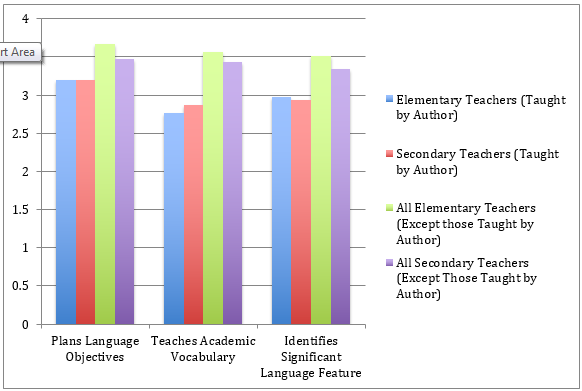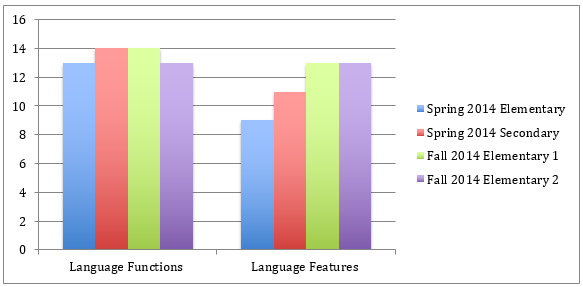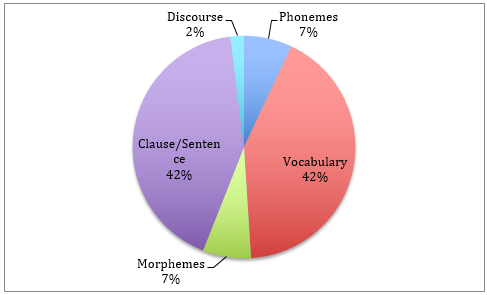|
NOTE: This article has not been copyedited due to its length.
A persistent achievement gap between emergent bilingual
learners (BLs) and native English speakers in U.S. schools
impels teacher educators who seek to improve learning opportunities for
BLs to study their efforts. The situation is especially dire in urban
areas of Massachusetts where drop rates and reclassification of BLs with
special needs have increased dramatically since bilingual education was
replaced with sheltered English instruction (SEI) through a voter
referendum in 2002 (Uriarte & Tung, 2009). As of 2013, the state
education department mandated all teachers complete an SEI course to
prepare them to work with emergent BLs. However, research on the
effectiveness of this preparation is urgently needed. Accordingly, this
self study, a form of practitioner inquiry that takes place in a higher
education setting (Cochran-Smith & Lytle, 2009, see Madigan
Peercy and Sharkey, this newsletter) focused on the following questions:
What difference can one course make? To what extent did an SEI course
taught within teacher education programs at a graduate school of
education prepare linguistically responsive teachers (LRTs).
Lucas and Villegas (2011) outlined orientations, knowledge and
skills of LRTs: that is, specialized language-based
expertise needed to teach emergent BLs. In brief, LRTs must recognize
how their own and students’ language and culture influence teaching and
learning; build on BLs’ backgrounds and proficiencies (DeJong &
Harper, 2005; Lucas & Villegas, 2011); scaffold instruction
(Gibbons, 2015; Walqui, 2006); and integrate language and content
instruction (Echevarría, Vogt & Short, 2013; Zwiers, 2014).
However, most U.S. teachers are monolingual English speakers
with limited second language experience (Cochran-Smith &
Zeichner, 2005); Language must become visible to teachers (Harper
& De Jong, 2004) before they can teach language demands of
classroom tasks and texts (de Jong & Harper, 2005; Santos,
Darling-Hammond & Cheuk, 2012). A primary goal of the SEI course
is to enable mainstream teachers to “see” language and explicitly teach
it. Therefore, in the course we model how language instruction can be
featured in lessons through language objectives, which focus on how
students use language to access, engage in, and demonstrate content
learning (Schall-Leckrone & McQuillan, 2014). Kinsella (2011)
provided a useful template to create language objectives with two
components: language functions and language features: for instance,
“Students will describe characters in a novel using precise adjectives. WIDA Standards (2007; 2012)
provide numerous examples of language functions within content lessons
according to English proficiency levels. Language features are discrete
language parts: phonemes, morphemes, grammar, syntax, and pragmatics
that provide students (and teachers) with a meta-language to describe
how words and word groups are formed and ordered. Academic language
functions and features must be taught, so language is no longer the
hidden curriculum preventing academic achievement (Schleppegrell, 2004;
Zwiers, 2014).
Research design
A social justice vision guided this self study— conducted
within my practice as a teacher educator at a private university in the
northeastern United States—as I believe BLs should have the opportunity
to develop language skills that equip them for school success,
professional employment, and civic engagement. Consistent with
practitioner inquiry, study participants were “regarded as knowers,
learners, and researchers,” so both practitioners’ and participants’
views of these research questions were examined (Cochran-Smith &
Lytle, 2009, p.42). To what extent do participants in the SEI course
develop orientations, knowledge, and skills of LRT teachers? Can they
identify and teach language demands of classroom tasks? To understand
how well participants were prepared to teach language during the SEI
course, surveys and assignments were collected and analyzed from
2013-15.
The SEI course—offered in 4-credit elementary and secondary
versions at our university— is designed to equip teachers with knowledge
and skills to teach the growing population of emergent BLs in
mainstream classrooms. Of 158 course
participants who consented to participate in the study, most were
female, aspiring elementary teachers between the ages of 29-37, and 92%
were native English speakers. Data was collected in the classes of five
bilingual course instructors with significant prior experience working
with BLs in K-12 and higher education in US and international contexts.
Data Analysis
Mixed methods were used to examine teacher preparation to teach
language. Pre and post course surveys were analyzed to better
understand participants’ perspectives of SEI preparation; Specifically,
paired T-tests were conducted using SPSS and open response survey
portions were coded. In addition, five practitioners evaluated
participants’ ability to teach language in a final lesson plan
assignment. I further analyzed lesson plans from my courses to determine
whether language objectives contained language functions and features
and which types of language features were identified. Multiple
viewpoints: practitioners’ and participants’ and mixed methods provided a
comprehensive approach to assessing the influence of the SEI course on
equipping teachers to teach BLs language.
Participants’ Views
Participants felt their ability to identify and teach language
increased in the SEI course. Their survey responses (using a Likert
scale: 1-strongly agree, 2- agree, 3- uncertain, 4- disagree, 5-
strongly disagree) demonstrated a statistically significant change from
the pre-to post survey (See Table 1).
Table 1: Statements regarding participants’ ability to identify and teach language
|
Statements |
Pre-mean |
Post-mean |
Mean change |
t |
p-value |
Direction of
Mean change |
|
I can identify basic
structures and functions of
language. |
2.1 |
1.8 |
-.30 |
3.5 |
*.001 |
Agree to Strongly Agree |
|
I know how to plan language objectives for my classes. |
2.84 |
1.90 |
-.94 |
12 |
*.000 |
Uncertain to Agree |
Participants agreed they could “identify basic structures and
functions of language” and strongly agreed with this statement on the
post-survey. Similarly, on the post survey, participants agreed they
could “plan language objectives for . . . classes.” However, open
responses on the post-survey suggested they would need support to apply
coursework understandings of language in classrooms.
Participants felt they would benefit from more practice
implementing language objectives with real students in classroom
settings. As one student noted, “At this point, I feel like practice is
the best teacher” (emphasis in the original). Similarly, another student
suggested more opportunity to work directly with students during the
course would have been beneficial. And another added, “Since I don’t
have . . . classroom experience, I . . . need . . . support from an SEI
expert [to] help me in a classroom situation.” Participants recognized
the need to receive site-based coaching with real BLs in classroom
settings.
Practitioners’ viewpoints
Practitioners evaluated how well participants identified and
taught language in lesson plans that were drafted, taught, reviewed by
peers, revised then submitted. Lesson components such as: language
objectives, academic vocabulary and language features were rated with a
rubric, as follows: 1 (Unsatisfactory), 2 (Developing Skills), 3
(Proficient), and 4 (Distinguished).
Figure 1: How Practitioners Rated Participants’ Ability to Teach Language

Practitioners felt most participants demonstrated proficiency
in planning language objectives, teaching academic vocabulary and
significant language features. Elementary teachers generally seemed more
skilled at identifying language than secondary participants perhaps due
to prior coursework on teaching reading. In addition, participants
seemed more successful at crafting language objectives than teaching
specific academic vocabulary or language features. That is, they could
identify important academic vocabulary or language features but not
fully demonstrate how to teach them in lessons. As participants
suggested, they would benefit from coaching with real students in
schools to develop facility embedding language-focused instruction
throughout lessons. Finally, I evaluated lesson plans more critically
than other practitioners, demonstrating a need to calibrate our rubric
usage.
To understand how students conceptualized language in lesson
plans, I also analyzed how 56 students from four course sections that I
taught in 2014 created language objectives, specifically, whether
language objectives contained language functions and features (see
Figure 2), and which types of features appeared in their objectives (see
Figure 3).
Figure 2: Language Objectives: Functions and Features

Most participants included language functions in their language
objectives— how WIDA standards with which students worked throughout
the course are expressed. Participants’ ability to identify language
features increased in subsequent iterations of the course, which I
attribute to instructional improvements not student differences. SEI
course revision has focused on supporting students in identifying and
teaching language features through language objectives, so I also
examined what types of language features were identified in language
objectives (See Figure 3).
Figure 3: Type of Language Features Identified in Language Objectives

Eighty-four percent of language objectives featured vocabulary
words or grammatical components of clauses or sentences (i.e. parts of
speech). Phonemes or morphemes, such as how to form plurals or create
word families with particular sounds, were a linguistic focus for early
childhood educators, a much smaller subset of participants.
The importance of teaching language demands of content texts
and tasks to emergent BLs has been established (Fang &
Schleppegrell, 2008; Harper & De Jong, 2004). As practitioners,
we became more adept at teaching how to create language objectives over
time. While the SEI course promoted mainstream teachers’ awareness of
their role as language teachers (de Jong & Harper, 2005) and
some ability to create language objectives, participants sought more
support to put language-based teaching strategies into practice in
classrooms. Participants and practitioners agreed: one course is
insufficient. At this point, we seem to be preparing linguistically
aware teachers rather than linguistically responsive ones.
Implications
A coherent approach to preparing linguistically responsive
teachers requires learning to be reinforced in multiple contexts from
coursework to the classroom. Participants recognized the benefit of
language objectives but felt they should have been introduced earlier
and practiced throughout their program of studies. Language knowledge
and skills should be infused throughout teacher education programs,
which requires professional development for all teacher educators.
Participants also sought opportunities to put coursework learning into
practice with real students and receive on-site support, which would
require more coordination between K-12 and higher education settings.
Further practitioner research—studies in both teacher education and K-12
classrooms— are recommended to improve learning opportunities for the
increasing number of emergent BLs taught in mainstream classes in
Massachusetts and beyond.
References
Cochran-Smith, M. & Lytle, S. (2009). Inquiry
as stance: Practitioner research for the next generation. New
York, NY: Teachers College Press.
Cochran-Smith, C & Zeichner, K. (2005). Executive
summary: The report of the AERA panel on research and teacher education.
In M. Cochran-Smith & K. Zeichner (Eds.), Studying
teacher education (pp. 1-36). Mahwah, NJ: Lawrence
Erlbaum.
De Jong, E. J. & Harper, C.A. (2005). Preparing
mainstream teachers for English- language learners: Is being a good
teacher good enough? Teacher Education Quarterly,
101-124.
Echevarria, J., Vogt, M.E. & Short, D.J. (2013). Making
content comprehensible for English learners: The SIOP Model
(4th Edition). Pearson: Boston, MA.
Fang, Z. & Schleppegrell, M. J. (2008). Reading in secondary content areas: A
language-based pedagogy. Ann Arbor, MI: The University of Michigan Press. 39-63.
Gibbons, P. (2015). 2nd
Edition. Scaffolding language, scaffolding learning: Teaching
second language leaners in the mainstream classroom. Portsmouth, NH: Heinemann.
Harper, C. & DeJong, E. (2004). Misconceptions about
teaching English language learners. Journal of Adult &
Adolescent Literacy, 48(2), 152-162.
Kinsella, K. (2011). Linguistic scaffolds for writing
effective language objectives. Unpublished document.
Lucas, T. & Villegas, A.M. (2011). A framework for
preparing linguistically responsive teachers. In T. Lucas (Ed.) Teacher preparation for linguistically-diverse classrooms: A
resource for teacher educators. New York: Routledge.
Santos, M., Darling-Hammond, L. & Cheuk, T. (2012).
Teacher development to support English language learners in the context
of the Common Core State Standards. Understanding language:
Language, literacy, and learning in the content areas.
Stanford University working papers.
Schall-Leckrone, L & McQuillan, P.J. (2014). In J.
Nagle (Ed.) Creating collaborative learning communities to
improve English learner instruction: College faculty, school teachers,
and pre-service teachers learning together in the 21st century. Charlotte, NC: Information Age Publishing, Inc.
Schleppegrell, M.J. (2004). The language of schooling:
A functional linguistics perspective. Mahwah, NJ: Lawrence
Erlbaum Associates.
Uriarte, M. & Tung, R. (2009) “English Learners in
Boston Public Schools in the Aftermath of Policy Change: Enrollment and
Educational Outcomes, AY 2003-AY2006.” The Mauricio Gaston Institute,
University of Massachusetts Boston, MA.
Walqui, A. (2006). Scaffolding instructional for English
language learners: A conceptual framework. The International
Journal of Bilingual Education and Bilingualism, 9(2),
159-180.
WIDA English Language Proficiency Standards (2007/2012).
Available at http://www.wida.us
Wright, W. E. (2015). 2nd Edition. Foundations for teaching English Language Learners. Research,
theory, policy, and practice. Philadelphia: Caslon
Publishing.
Zwiers, J. (2014). 2nd ed.
Building academic language: Meeting Common Core Standards across
disciplines, grades 5-12. San Francisco, CA: Jossey- Bass.
Laura Schall-Leckrone is an assistant professor and program director of TESOL and bilingual education at the Graduate School of Education at Lesley University in Cambridge, Massachusetts. She has worked as a bilingual educator and curriculum director in U.S. public schools. Her research focuses on teacher preparation and pedagogy that promotes critical literacies for bilingual learners. | 
